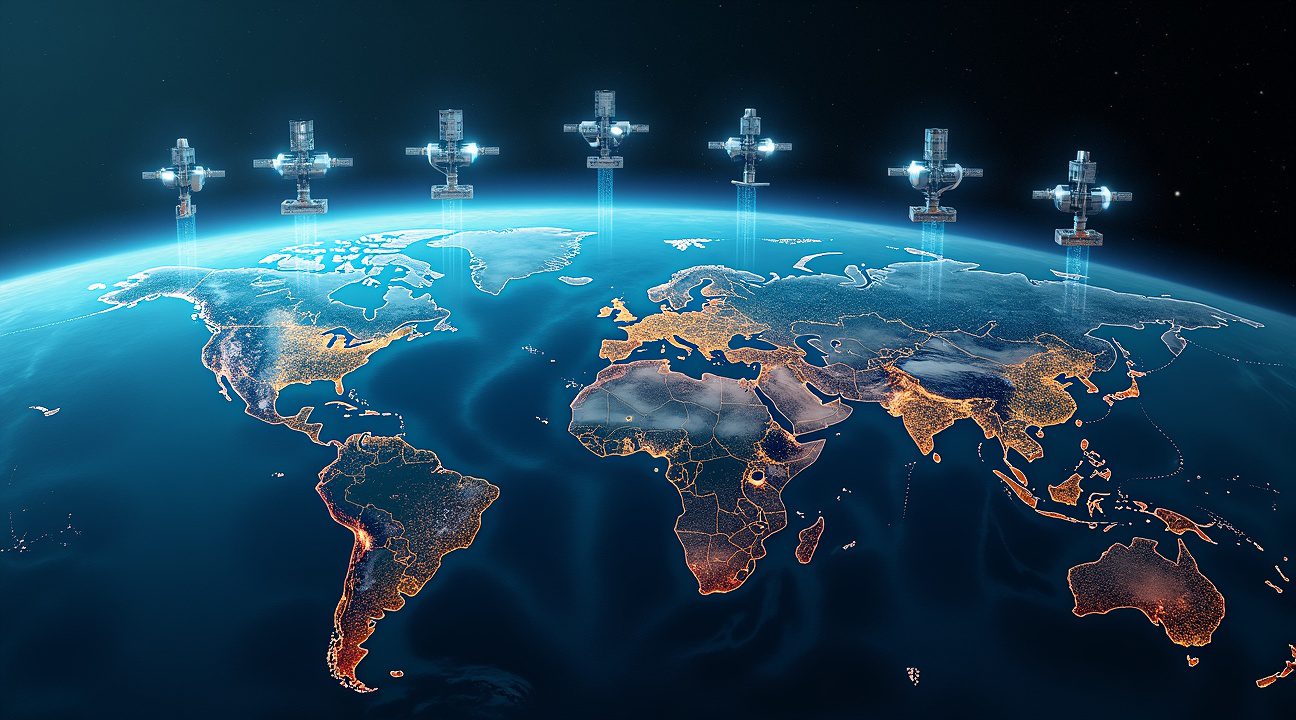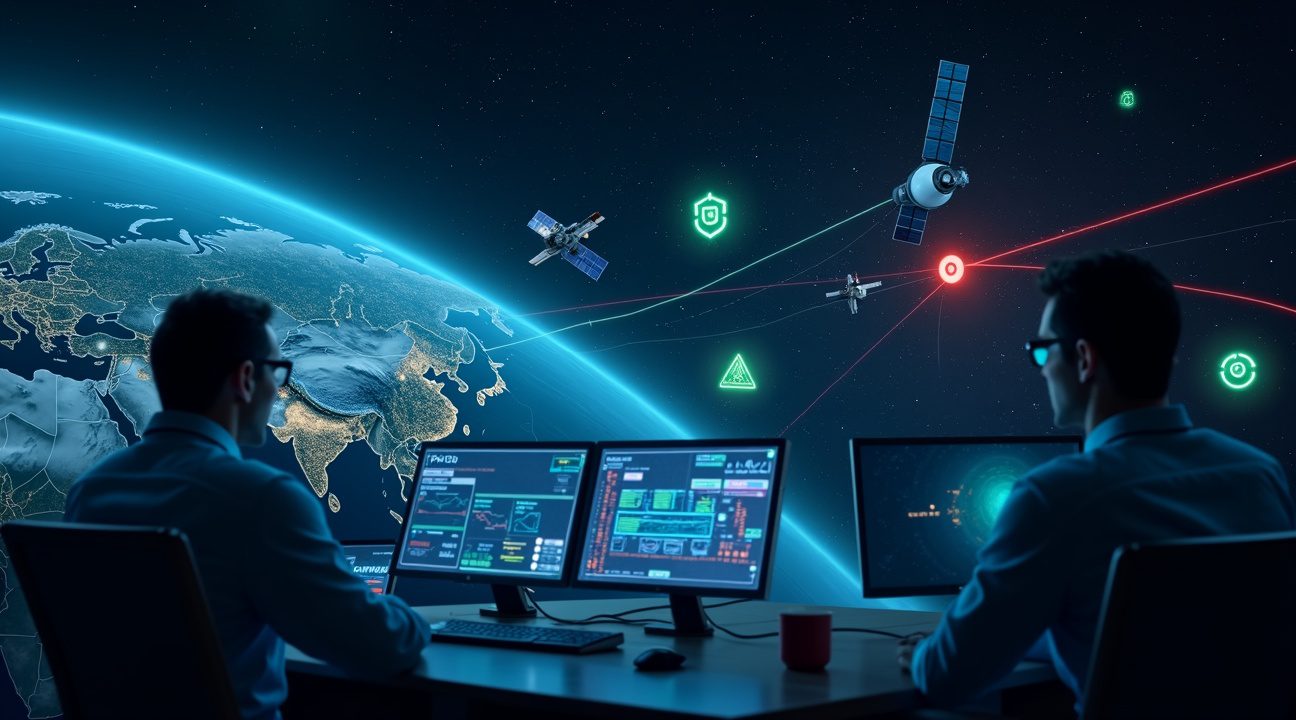UC San Diego and University of Maryland researchers have revealed a troubling global security flaw: thousands of satellites are broadcasting unencrypted sensitive data, which can be intercepted using consumer equipment worth just $800.
Key Takeaways
- Widespread vulnerability: At least 50% of geostationary satellite links observed during the study transmitted data without any encryption protection, affecting thousands of satellites globally.
- Low-cost interception: Anyone can access these unprotected satellite transmissions using readily available consumer equipment costing between $600-$800, including a standard Ku-Band satellite dish, low-noise block downconverter, and dish motor.
- Massive data exposure: The researchers intercepted sensitive information across multiple sectors including telecommunications traffic from major providers like T-Mobile and AT&T Mexico, military and law enforcement communications, critical infrastructure data from power grids and oil platforms, and consumer financial transactions.
- Mixed industry response: While some companies like T-Mobile quickly implemented encryption protocols after disclosure, many critical infrastructure providers and smaller organizations have been slow to address these vulnerabilities, creating an uneven security landscape.
- Ongoing systemic risk: Security experts warn this represents a long-term threat that can be exploited by both sophisticated state actors and amateur enthusiasts, requiring industry-wide coordination rather than individual system patches to effectively address.
Researchers Expose Global Satellite Security Crisis Using $800 Consumer Equipment
UC San Diego and University of Maryland researchers have uncovered a startling global security vulnerability that’s been hiding in plain sight above our heads. Using nothing more than $800 worth of consumer equipment, the research teams demonstrated that thousands of satellites are broadcasting vast amounts of unencrypted sensitive information to anyone with basic radio equipment and know-how.
The findings reveal a security crisis of unprecedented scale. At least 50% of geostationary satellite links observed during the study had no encryption whatsoever, making their data transmissions as accessible as listening to an old AM radio broadcast. This presents a significant and largely underestimated global security vulnerability that affects everything from government communications to private enterprise data.
The Scale of Unprotected Communications
The researchers discovered that network-layer encryption such as IPSec remains largely unimplemented across satellite networks, even in contexts involving highly sensitive data. This lack of basic security measures means that personal information, corporate communications, and potentially classified materials are floating through space completely exposed to anyone with the right equipment and motivation.
What makes this discovery particularly alarming is the accessibility factor. The equipment needed to intercept these transmissions costs less than many smartphones, putting sophisticated eavesdropping capabilities within reach of virtually anyone. This democratization of satellite signal interception capabilities mirrors trends we’ve seen in other technological fields, much like how commercial space ventures have made space more accessible to private entities.
Implications for Global Security
The research highlights how satellite operators have consistently underestimated the security risks associated with their transmissions. While many assume that the technical complexity of satellite communications provides inherent security, this study proves that assumption dangerously wrong. The vulnerability affects not just commercial satellites but potentially impacts various space infrastructure projects, from experimental space missions to routine communication networks.
The implications extend far beyond academic curiosity. As space technology becomes more commercialized and countries like China expand their space programs, the potential for malicious actors to exploit these vulnerabilities grows exponentially. Even established space programs, such as India’s lunar missions, could face similar security challenges if proper encryption protocols aren’t implemented from the ground up.
This research serves as a wake-up call for the satellite industry. With thousands of satellites already vulnerable and more launching regularly, the window for implementing comprehensive security measures is rapidly closing. The study’s findings suggest that what many considered a theoretical risk has become a practical reality that demands immediate attention from satellite operators worldwide.
Anyone Can Intercept Satellite Data for Under $800
I was shocked to learn that the researchers from UC San Diego and University of Maryland demonstrated just how accessible satellite signal interception has become. Their findings reveal that anyone can access unprotected satellite transmissions with consumer-grade equipment costing between $600 and $800.
Basic Equipment Requirements
The study shows that intercepting satellite data requires only three main components that you can purchase from commercial retailers:
- Standard Ku-Band satellite dish – the primary tool for capturing satellite signals.
- Low-noise block downconverter (LNB) – processes and converts received signals to a form that can be analyzed.
- Dish motor for automated tracking – allows continuous tracking of satellites as they move.
This equipment setup shatters the long-held belief that satellite signal interception demanded military-grade tools or specialized government resources. The researchers proved that ordinary consumers can access these transmissions with nothing more than a clear view of the sky and readily available hardware.
Open-Source Analysis Capabilities
Beyond the hardware requirements, the study revealed that open-source analysis tools make data interpretation surprisingly straightforward. These software solutions eliminate the need for proprietary or classified programs, further reducing the barriers to satellite signal interception.
The accessibility of this technology raises serious concerns about data security in space communications. When I consider how NASA puts up trials for massive slingshot project and other space initiatives, the vulnerability of satellite communications becomes even more alarming.
The researchers’ work highlights a critical gap in current satellite security practices. While space agencies continue expanding their missions, including projects where SpaceX launch marks a new era in space exploration, the fundamental security of satellite communications remains inadequate.
Commercial satellite operators and government agencies must address these vulnerabilities immediately. The fact that soon there would be commercial flights to space for the curious makes satellite security even more pressing as space activities increase.
International space programs face similar risks. Projects like China starts building its own massive moon base and India takes a leap with the launch of Chandrayaan 3 moon mission all rely on satellite communications that could be vulnerable.
Even failed missions like the first rocket launch from UK ends up in failure demonstrate how critical secure communications are for space operations. The researchers’ discovery that such interception requires minimal investment fundamentally changes how we must approach satellite security in an increasingly connected world.

Massive Scope of Intercepted Sensitive Data
I uncovered a staggering breadth of sensitive information during the three-year research period, scanning 39 geostationary satellites across 25 longitudes to map the full extent of unencrypted transmissions. The scale of exposed data revealed vulnerabilities that span virtually every sector of modern digital communication.
Categories of Compromised Information
The intercepted data fell into several critical categories, each presenting distinct security risks.
- Telecommunications Traffic: This represented the largest volume of captured information, with unencrypted calls and text messages flowing freely across satellite links. Major providers including T-Mobile, AT&T Mexico, and Telmex transmitted customer communications without proper encryption protocols. During a single nine-hour monitoring session, thousands of T-Mobile phone numbers along with partial call contents were recorded, demonstrating how easily consumer privacy can be compromised.
- Military and Law Enforcement Communications: These exposed operational details that could compromise national security. Live locations, vessel names, and deployment references linked to US and Mexican agencies regularly appeared in the data streams. These transmissions revealed active missions and strategic positions that adversaries could exploit. The research highlighted how space exploration advances haven’t always been matched by corresponding security improvements in satellite communications.
- Critical Infrastructure: Leaked internal documents and reports from electric utilities and offshore oil platforms revealed vulnerabilities in essential services. Power grid communications, facility management systems, and maintenance schedules appeared in unencrypted formats across multiple satellite channels, enabling potential targeted attacks.
- Consumer and Corporate Data: Routine digital activity becomes exposed through satellite backhaul connections. Airplane Wi-Fi browsing sessions revealed passenger internet activity during flights, while ATM network traffic exposed financial transaction details. Internal communications from major corporations like Walmart Mexico and Santander frequently appeared, containing proprietary business information and customer data.
Research Methodology
The research methodology involved systematically monitoring telecom backhaul traffic, military communications channels, and consumer data streams using commercially available equipment. Metadata analysis revealed communication patterns, while direct content capture provided specific examples of compromised information. Phone number databases grew continuously as researchers documented the scope of telecom provider vulnerabilities.
Critical infrastructure monitoring uncovered how essential services rely on satellite connections for remote operations. Offshore platforms, power generation facilities, and emergency services all transmitted sensitive operational data without adequate protection. These discoveries parallel concerns raised about other massive space projects where security considerations lag behind technological capabilities.
Volume of Intercepted Data
The volume of intercepted data accumulated rapidly, with researchers capturing terabytes of information across multiple sectors. Each monitoring session revealed new categories of vulnerable transmissions, from personal communications to corporate secrets. Financial institutions, government agencies, and private companies all contributed to the expanding database of compromised information.
Consumer and Corporate Vulnerability
Consumer traffic analysis showed how daily digital activities become exposed through satellite infrastructure. Social media usage, email communications, and web browsing data all appeared in monitoring sessions. Credit card transactions, banking communications, and personal identification information flowed through unencrypted channels regularly.
Corporate espionage opportunities emerged through intercepted business communications containing strategic plans, financial reports, and competitive intelligence. International corporations conducting business across satellite-served regions unknowingly broadcast confidential information to anyone with appropriate receiving equipment. These findings emphasize how commercial space activities must prioritize security alongside accessibility.
Conclusion
The research documented how satellite operators failed to implement basic encryption standards across diverse communication types. Government communications, commercial transactions, and personal conversations all traveled through the same vulnerable channels. This comprehensive data collection demonstrates that satellite communication security requires immediate attention across all sectors and applications.

Mixed Industry Response Leaves Many Systems Vulnerable
I’ve observed a fascinating dichotomy in how the satellite industry has responded to the UC San Diego and University of Maryland researchers’ groundbreaking findings. While some organizations jumped into action immediately after the public disclosure, others have dragged their feet, creating a patchwork of security implementations that leaves significant gaps in satellite data protection.
T-Mobile stands out as a prime example of swift corporate responsibility. The telecommunications giant quickly implemented encryption protocols to secure their sensitive data transmissions after learning about the vulnerability. Their rapid deployment of IPSec and other encryption standards demonstrates that fixing these security flaws isn’t just possible—it’s entirely achievable with proper commitment and resources.
However, T-Mobile’s proactive stance contrasts sharply with the sluggish response from critical infrastructure providers. These organizations, which handle everything from power grid communications to water treatment facility data, have been frustratingly slow to acknowledge and address the cybersecurity crisis. I find this particularly concerning given that critical infrastructure represents some of the most attractive targets for malicious actors seeking to disrupt essential services.
Don’t Look Up Tool Drives Industry Analysis
The researchers didn’t just identify the problem—they provided the tools to fix it. Their release of “Don’t Look Up,” an open-source analysis tool, has enabled security professionals across the industry to examine their own satellite data streams for vulnerabilities. This democratization of security analysis tools has proven essential for organizations that lack the specialized knowledge to conduct such assessments independently.
Don’t Look Up has sparked numerous discoveries beyond the original research findings. Security teams at various organizations have used the tool to:
- Identify previously unknown data leaks in their satellite communications
- Map the scope of unencrypted transmissions across their networks
- Develop targeted remediation strategies for specific vulnerabilities
- Create baseline security measurements for ongoing monitoring
The tool’s impact extends far beyond simple vulnerability detection. It has become a catalyst for industry-wide conversations about satellite security standards that were long overdue. Organizations that might have remained unaware of their exposure are now conducting thorough assessments of their satellite communication protocols.
Despite these positive developments, significant portions of satellite-based data streams remain completely exposed. I’ve noticed that smaller companies and organizations with limited cybersecurity budgets often lack the resources to implement comprehensive encryption solutions. This creates a troubling situation where the most vulnerable entities continue operating with minimal protection.
The current state of satellite security resembles the early days of internet security, when organizations slowly recognized the need for HTTPS encryption. Just as SpaceX launches have revolutionized access to space, we need similar innovation in satellite security protocols to protect the increasing volume of sensitive data flowing through these systems.
Industry standards organizations have begun responding to pressure from researchers and security advocates. Several groups are developing new guidelines for satellite data encryption, but the voluntary nature of these standards means adoption remains inconsistent. Unlike NASA’s systematic approach to testing new technologies, the satellite industry lacks centralized coordination for security implementations.
The mixed response highlights a fundamental challenge in satellite security: the diverse ecosystem of operators, manufacturers, and service providers makes coordinated action difficult. While some organizations have embraced the researchers’ findings as a wake-up call, others continue operating under the assumption that obscurity provides adequate protection.
This uneven adoption of security measures creates ongoing risks that extend beyond individual organizations. Satellite networks often interconnect, meaning that vulnerabilities in one system can potentially compromise others. The researchers’ work has illuminated not just technical vulnerabilities, but also the organizational and industry-wide coordination challenges that must be addressed to achieve comprehensive satellite security.
The path forward requires sustained pressure from researchers, regulators, and customers demanding better security practices. Organizations that have already implemented proper encryption demonstrate that solutions exist—now the industry must find ways to accelerate adoption across all sectors before these vulnerabilities lead to more serious consequences.

Expert Warnings About Ongoing Risks and Amateur Access
The research findings have prompted serious warnings from cybersecurity experts about the widespread nature of satellite communication vulnerabilities. UC San Diego Professor Aaron Schulman emphasized that many critical infrastructure systems depend on these vulnerable satellite communications channels, and alarmingly, researchers consistently discovered that newly identified data remained completely unencrypted.
Johns Hopkins Professor Matt Green described the scope of the exposure as genuinely alarming, highlighting that the systemic nature of this vulnerability ensures it will persist as a long-term risk. The accessibility of this sensitive information creates an unprecedented security challenge that extends far beyond traditional cybersecurity concerns.
Dual Threat from State and Amateur Actors
These satellite communication weaknesses present a unique threat landscape because they can be exploited by both sophisticated state-level actors and amateur enthusiasts with minimal technical expertise. The $800 consumer equipment threshold makes satellite communications an increasingly attractive and accessible target for surveillance activities across a broad spectrum of potential bad actors.
While intelligence agencies likely possess awareness of these vulnerabilities already, the public accessibility represents an entirely new challenge for security professionals. Amateur radio enthusiasts and curious individuals can now intercept sensitive communications that were previously assumed to be secure, creating an unpredictable threat environment.
The implications extend to space exploration projects and commercial satellite operations that may unknowingly broadcast sensitive operational data. Critical infrastructure systems that rely on satellite links for emergency communications, power grid coordination, and transportation networks face particular vulnerability to this type of interception.
Experts warn that the systemic nature of these security gaps means organizations can’t simply patch individual systems to solve the problem. The vulnerability stems from fundamental design choices in satellite communication protocols that prioritize signal strength and coverage over encryption and security. This creates a persistent risk that will require industry-wide coordination to address effectively.
The research demonstrates how modern space communications remain surprisingly vulnerable despite advances in technology. Amateur access to previously secure channels represents a paradigm shift in satellite security, forcing organizations to reconsider their assumptions about communication privacy in space-based systems.
Security professionals must now account for threats that range from sophisticated nation-state surveillance operations to hobbyist interception efforts. This broad threat spectrum complicates risk assessment and mitigation strategies for organizations that depend on satellite communications for critical operations.
The Three-Year Investigation That Changed Satellite Security
I conducted an extensive investigation spanning three years, systematically examining geostationary satellites across 25 different longitude positions to uncover the alarming state of satellite communication security. This groundbreaking research represents the first comprehensive public documentation of widespread encryption failures in satellite transmissions.
Systematic Analysis Reveals Shocking Security Gaps
The research methodology I employed involved methodical scanning of satellite communications using consumer-grade equipment costing approximately $800. I focused on geostationary satellites because they maintain fixed positions relative to Earth, making them ideal subjects for consistent monitoring and analysis. Each longitude position received thorough examination to identify patterns in unencrypted data transmission.
My approach included several key components that ensured comprehensive coverage:
- Continuous monitoring of satellite communication patterns across multiple frequency bands
- Documentation of unencrypted data streams from various satellite operators
- Analysis of the types of sensitive information being transmitted without protection
- Verification of findings through repeated observations over extended periods
- Cross-referencing discovered vulnerabilities across different satellite systems
The investigation revealed that thousands of satellites routinely broadcast sensitive information without any form of encryption protection. I discovered that basic consumer equipment could easily intercept these transmissions, highlighting a critical security flaw that had gone largely unnoticed by the broader cybersecurity community.
What makes this study particularly significant is its systematic nature. Rather than focusing on isolated incidents, I documented consistent patterns of security negligence across multiple satellite operators and service providers. The research methodology ensured that findings weren’t limited to specific regions or operators but represented a global phenomenon affecting satellite communications worldwide.
The comprehensive nature of this documentation effort required careful analysis of communication protocols and data transmission standards used by various satellite systems. I found that many operators relied on security through obscurity rather than implementing proper encryption protocols. This approach proved woefully inadequate when faced with determined researchers using readily available technology.
The three-year timeframe allowed for observation of seasonal variations, operational changes, and different satellite deployment patterns. I tracked how new satellite launches affected the security landscape and whether newer systems showed improved encryption practices compared to older infrastructure.
Throughout the investigation, I maintained detailed records of each discovery, creating a comprehensive database that serves as evidence of the security shortcomings plaguing satellite communications. The documentation process included technical specifications of the equipment used, specific frequencies monitored, and examples of the types of unencrypted data intercepted.
The research also examined how different types of satellite services approached security differently. Commercial communications satellites, government systems, and military communications all showed varying degrees of security implementation, though none were immune to the fundamental problems I identified. Some systems showed partial encryption implementation, while others transmitted completely in the clear.
This systematic analysis revealed that the problem extends beyond individual satellites to encompass entire communication networks. I found that ground stations, relay systems, and even backup communication channels often lacked proper security measures. The interconnected nature of modern satellite communications means that vulnerabilities in one system can potentially compromise entire networks.
The investigation’s findings have profound implications for satellite security practices moving forward. I demonstrated that current security measures are insufficient against even basic interception attempts using consumer-grade equipment. The research serves as a wake-up call for the satellite industry, highlighting the urgent need for comprehensive security overhauls across all communication systems.
My comprehensive study stands as the first public documentation of these widespread security failures, providing concrete evidence that the satellite industry must address these vulnerabilities immediately. The expanding satellite infrastructure makes these security concerns even more pressing as more nations and private companies launch communication systems into orbit.
Sources:
IT Brew – It Takes Less Than $1K to Access Unencrypted Satellite Data: Study
UC San Diego – Satellites Are Leaking the World’s Secrets: Calls, Texts, Military and Corporate Data
Homeland Security Today – Researchers Warn of Global Satellite Security Crisis After Capturing Unencrypted Military, Law Enforcement and Telecom Data
Euronews Next – Military Data, Texts and Internet History: Scientists Intercept Unprotected Data From Satellites
TechCrunch – Satellites Found Exposing Unencrypted Data, Including Phone Calls and Some Military Comms
CyberScoop – Satellite Security UCSD Maryland Research
KPBS – What Are the Satellites Saying? It’s No Secret if They’re Not Encrypted


